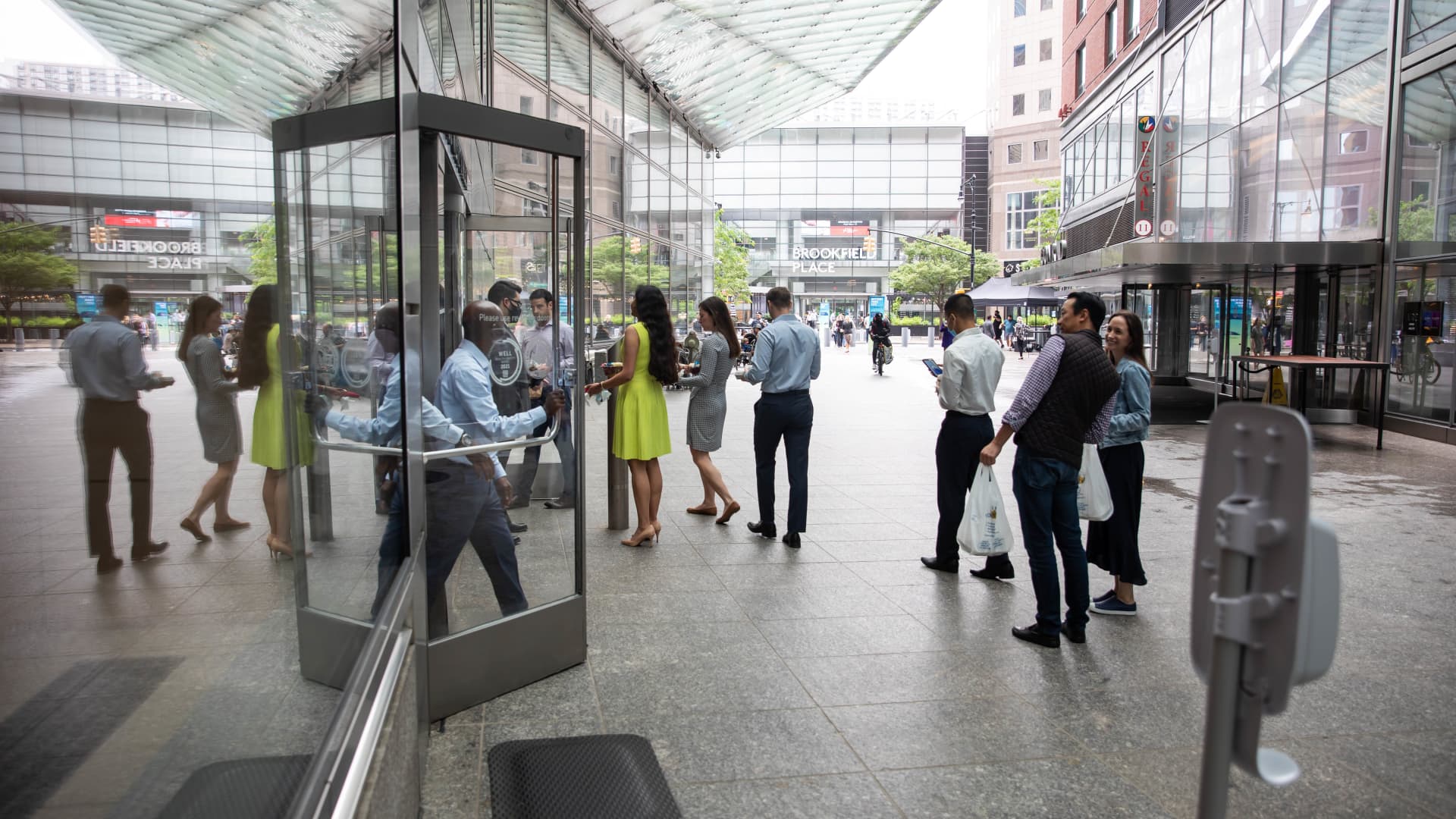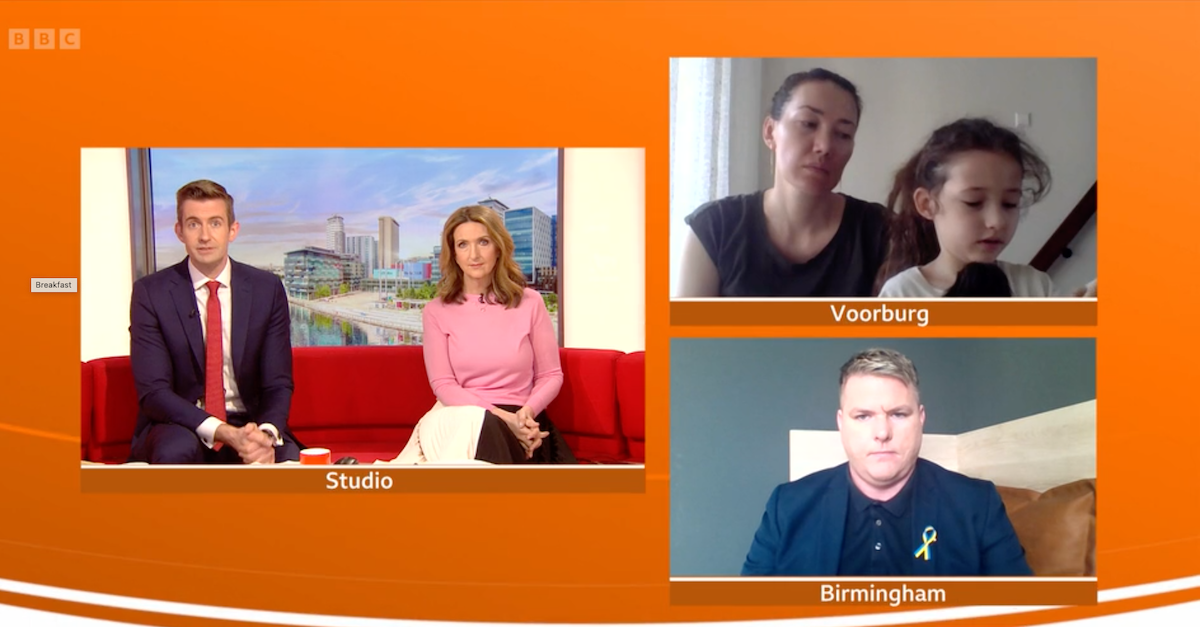Full return to office isn't the only work model dying. So is fully remote
We have a winner in the post-pandemic work model war between employees and bosses. It's not full return to office, and it's not fully remote.

People wait in line to enter the Goldman Sachs headquarters building in New York, U.S., on Monday, June 14, 2021. Goldman Sachs Group Inc. is bringing thousands of employees back to the office across the U.S. Monday for the first time in more than a year. Photographer: Michael Nagle/Bloomberg via Getty Images
Bloomberg | Bloomberg | Getty Images
When you speak with chief human resource officers at major companies asking employees to come back to the office with more frequency, most issue a common refrain about the work-from-home debate: Can't we just stop talking about it already?
Some have tried to end the argument. "Return to office is dead," a Stanford WFH guru recently declared. Now, new survey data suggests that if the five-day-a-week-in-an-office era is over, it's not the only work model headed for extinction. As the workplace stabilizes in a new normal, the golden age of WFH isn't just coming to a close. Fully remote work is all but dead, too, according to a new EY survey.
Only 1% of over 500 business leaders surveyed by EY say that their companies are fully remote, according to its third annual Future of Work Index, released on Monday. The number is a stark contrast to 2022, when 34% of companies were virtual. Between 2019 and 2021, the number of employees who worked fully from home tripled. Many of them ended up embracing their new working conditions, citing benefits such as no commute, added flexibility, and increased opportunities.
But as work from home peaked, business leaders started speaking out about their disdain for the remote model. Even CEOS who have taken companies to a remote model for reasons of cost, employee quality of life, and diverse hiring goals, say it requires a sacrifice of key corporate goals.
"Leadership is thinking, 'I think we're losing some of our culture. We're losing some of our training, growth, and professional development,'" said Mark Grinis, who leads EY Americas' Real Estate, Hospitality and Construction sector.

Throughout the pandemic, most corporations indicated that they were preparing for a hybrid work model, and the EY data suggests that is where many have ended up today. The survey found that 80% of leaders are confident in their current hybrid work strategy. Over the past few years, employers have seen a considerable rise in productivity, with 80% of executives reporting their employees' productivity was somewhat or much higher over the past 24 months.
"Hybrid does not seem to damage innovation," economist and WFH expert Nicholas Bloom — who made the recent "return to office" death proclamation — recently told CNBC. "Folks come into the office three days a week and WFH for two days a week. It seems three days of facetime a week, if coordinated amongst employees so they all come in on the same anchor days, appears sufficient. Hybrid has become dominant because of this."
For a hybrid policy to be effective, the EY data shows companies need to incentivize employees to work in person. Twenty-one percent of employers face challenges in retaining and recruiting employees willing to come into the office. Grinis says leaders must be deliberate in their approach. "A lack of being certain and a lack of definition is not appreciated, and not as effective," he said.
Many companies (86%) have resorted to an in-office attendance mandate for a certain number of days a week. The EY survey finds 80% of companies having their employees head into the office three or more days a week.
While mandates can work, preserving the morale of employees requires some changes to the in-office experience, bringing it closer to the comforts of working from home. Amid fears of an apocalypse in the office real estate market, more than half (55%) of respondents to the EY survey at small companies and close to half (47%) at mid-size companies say they have increased their office space footprint over the past two years. About a third (32%) of employers say creating the right kind of space for their employees is among the biggest challenges, and are investing in newer high-tech office spaces with amenities (51% of employers), and more digital/virtual collaboration resources (63%).
"I think those days of, 'Let's see what people want' are quickly running out," Grinis said. "Now, management needs to lead." But he added that it "needs to lead with purpose, be definitive with policy, and look at [hybrid work] as a competitive angle in the marketplace."
Dave Stephenson, chief business officer at Airbnb — whose company moved to a "live and work anywhere model" during Covid — recently told CNBC that the company isn't "remote first" by policy across every function, and he said it "absolutely matters to work in person for training, for development, for implementation of new projects."
But Stephenson said there is no going back to five days a week in the office. "The horse has left the barn. Forty percent of our new employees are not within 50 miles of an office. … You don't need to be there, just to be there," he said.
For the majority of workers, though, it is looking more like you need to be there at least three days a week.
"It's clear that hybrid work is no longer in a test-and-see period; it's here to stay," Grinis said in the survey release.


 Koichiko
Koichiko 































